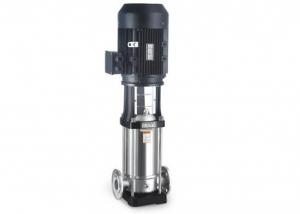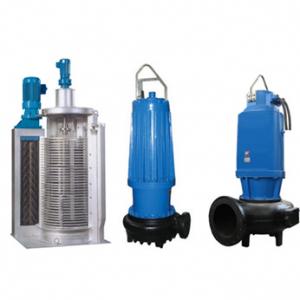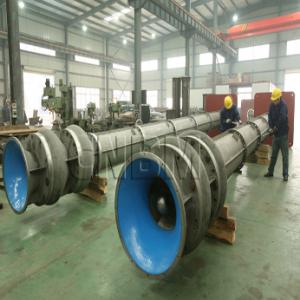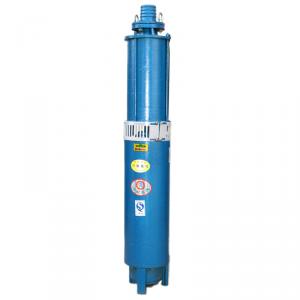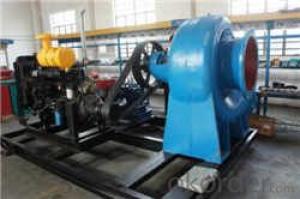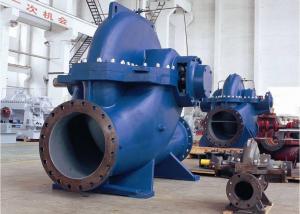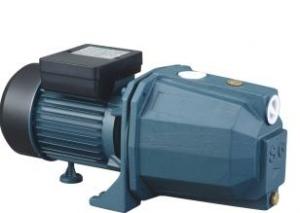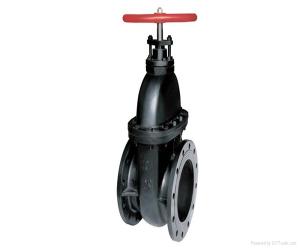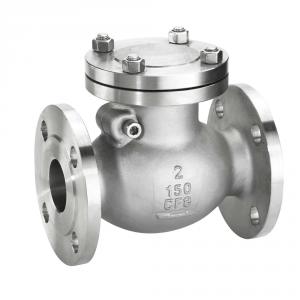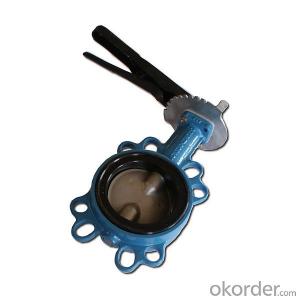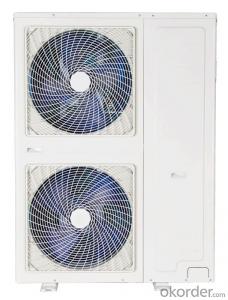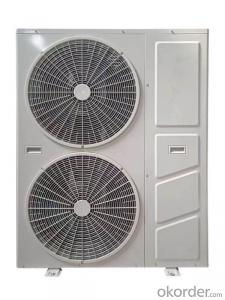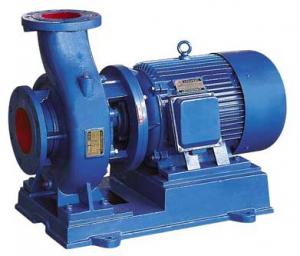TPG Type Vertical Inline Centrifugal Pump
- Loading Port:
- Shanghai
- Payment Terms:
- TT OR LC
- Min Order Qty:
- 1 set
- Supply Capability:
- 1000 set/month
OKorder Service Pledge
OKorder Financial Service
You Might Also Like
TPG series single stage vertical inline centrifugal pump is the second generation of high efficiency energy-saving product designed by our company based on many years of production experience as per the performance parameters stated in the internatonal standard ISO2858 and the national standard JB/T6878.2-93.This pump can also be used in oil and gasoil environment, for this condition, we make our pumps based on the new standard API 610 tenth edition It is an ideal substitute for normal pumps like SG and D multi-stage centifugal pumps. The series has a flow range of 1.5-1600m3/h and a lift head range of 5-125m, which includes many specifications like basic, diversion and cutting types. According to the difference in working medium and temperature as well as meterial and structural changes of the flow-through part, it can designed and manufactured into TPRG hot water pump,IHG pipeline chemical pump and YG pipeline oil pump with the same performance parameters. Accordingly, this series can be widely applied to replaced the normal centrifugal pump completely to be used in all cases.
Working Conditions:
1.Suction pressure ≤1.0MPa, or the maximum working pressure of pump system ≤1.6MPa, namely pump suction pressure +pump delivery head≤1.6MPa, pump static tes pressure at 2.5MPa. Please specify the working pressure of the system when placing an oeder. To acquired working pressure of pump system greater than 1.6MPa should be specified separately when placing an order for our conenience to use
2.Ambient temperature<40°C,relative humidity<95%.
3.Volume content of solid particles in medium to be delivered shouldn't exceed 0.1% of unit volume, granularity<0.2mm.
Note: to handle medium carring small particals, please specify when placing an order for our convenience to use wear resistant mechanical seal.
Rang of Application:
Daily and fire water supply for constructions,air conditioning system,cyclic pressurization for other cold and hot clean medium.
Type Designation:
TPG TPR TPHG TPYG TPGD 100-160 (I) A(B)
TPG – Vertical Inline Centrifugal Pump
100 – Diameter of pump inlet and outlet (mm)
160 – Nominsl diameter of impeller (mm)
I –Flow classification
A – Primary cutting of impeller
B – Secondary cutting of impeller
Technology Parameters:
Flow:1.5-1200m3/h;
Head:5-150m;
Power:0.18-250kw;
Rotary speed:980-2900r/min;
Cabilre:15-500mm;
Temperature range:-20°C-+120°C.
- Q:and how do I get it to work 24 hours a day?and on the pump there is written: 2 A, and on another part: 220-240 Vdoes that mean its wattage is 440-480Watt?
- Hey Don ..did you mean consecutive hours..if so. Here is how to do it..If there is fluid to be pumped there is sometimes a controller that will ask the pump to stop when it reaches low level . And again ON when it senses high level. Find this device, if one exists and either defeat it mechanically or wire around it electrically.Either is pretty simple. NOW that i have told you how to get it to run all the time. I though I might mention a timer..A timer, in series with your pump, will cut it off and give the liquid level a chance to rise as well. Timers can be defeated the same as all other protective devices,, My question is Are you sure this is what you want to do ? The plug on the end of the cord ,it must be a small pump if only 2 amps, should be your only control .If it has an auto off feature it's there to save your pump from burning the barn down ,so to speak, Why not take another look at your application. if you do have an endless fluid supply ,like a closed loop trickling fountain, remember those evaporate if make up water is not added. Sometimes though you need a pump to run 24-7 in which case just fool the controller..Of course the human is the true controller... :) Well I have armed you with enough info to get by on this please do so safely. From the E...
- Q:Dear friends, please let me know in most of the power plants recirculation line and balance leak off lines are provided for boiler feed water pumps and those lines are connected to Deaerator. Why?
- The feed pumps for most power plants are multistage centrifugal pumps. They have a minimum flow requirement or the balancing forces of the various impellers are lost and the pump is damaged. A recirculation line permits a minimum flow to be maintained at all times. It goes back to the deaerator so the boiler feedwater is not lost. Note: many of these pumps have the recycle automated so it is only in operation at very low flow rates. The leak off from the balancing line is recycled for the same reason.
- Q:my marine engine doesnt pump water can you tell me some faults can be thanks vic
- There are 2 water pumps. One in the stern drive, or mounted on the engine which takes the water your in to cool the engine. The other is a conventional circulating water pump, which is important in fresh water cooled engines . Most often it's the impeller failure.
- Q:I was looking at a water pump and the specs said 110 Foot Max. Total Head and 20 Foot Max. Suction Lift. Can someone please explain this? Thanks.
- Head is the height over the pump location that a pump can push water, suction lift is the depth it can lift it from. Picture a 130' well with the pump 20' from the bottom and 110' from the top- in that case it will pump it... but without a volume factor (how much is going to flow) it's impossible to determine whether you'll get a trickle or a flow with those conditions.The store or manufacturer should be able to supply that info. Also the heights are relevant to sea level (or actual location above sea level) not necessarily the pipe length.
- Q:My old pump burned up so i recently replaced it (with a refurbished pump) I have new pipe to the pump, new tank. my pump is a 1/2 hp 230v pump, I also replaced the control box. With my pump plugged in and the water coming straight out of the pipe bypassing the tank when I turn the power on I will get water for a minute or so then I won't get water for a minute. This will keep happening. I have checked the switch and when I quit getting water there is still power going to the pump. any suggestions or ideas? bad wiring or bad pump?...I know that there is water in thew well, the pump is located at 100 ft of a 115 ft well and i can see the water level about 10 ft underground.
- Your problem may be in the wire feeding down to the pump, the pump starts to run, the torque of the motor turning causes the wire to twist and causes the break in the wire to spread and open the circuit. This stops the pump, pump settles back in to position and restarts, seen this happen a lot. Pull the pump and inspect the wire from top to bottom very carefully.
- Q:When did the pump start?
- The promotion of water is very important to human life and production. There are various ancient water appliances, such as Egypt's chain pump (seventeenth Century BC), China shadoof (seventeenth Century BC), Burton (Eleventh Century BC) and water (first Century ad). The famous spiral rods invented by Archimedes in the third Century BC can lift water to a few meters in a steady and continuous way, and the principle is still used by modern screw pumps.In 200 BC, the ancient Greek fire pump craftsmen invented by Kurt Siby Lucius is a kind of piston pump has the most original, the main components of a typical piston pump piston pump, but only after the steam engine was developed rapidly.1840~1850 years, the United States invented Worthington pump cylinder and steam cylinder opposite, the direct impact of the piston pump, marking the formation of modern piston pumps. Nineteenth Century was the climax of the development of piston pumps, which were already used in a variety of machines, such as water presses. However, with the rapid increase in water demand, from 1920s, the piston pumps with low speed and large flow were gradually replaced by high-speed centrifugal pumps and rotary pumps. But in the field of high pressure and small flow, reciprocating pump still occupies the main position, especially diaphragm pump and plunger pump have their own advantages and are used more and more.
- Q:what makes pump come on every 10 seconds when water is on
- i'm assuming which you're pertaining to a nicely pump, and your suitable it sounds like it is working slightly too many times (short cycling). in many circumstances on a nicely gadget you will detect a stress tank, which will look after a reservoir of water at a somewhat consistent stress. The tank will empty as water is used interior the homestead until the nicely pump kicks in to replenish it. commonly this takes between 5 to 10 minutes, yet this time is extremely variable depending on length of take, stress placing, etc.. in case you're stress tank has develop into water logged it could account for the situation you're having, and you will would desire to recharge the tank with air. you will discover the air filler nozzle on the top of the tank on maximum fashions (apparently like a bicycle tire nozzle). in case you're nevertheless experiencing the situation afterwards then you certainly may well be wanting to purchase a sparkling stress tank (they often have a fifteen to 20 year existence span).
- Q:n my water pump hoses feels like theres no pressure
- dude its yur thermostat u need to replace it or it can even be yur coolant cap it can be on crooked or not on all the way look into both but ive had cars overheat on me for both reasons and ive had caars blow up on me due to both reasons so look into both
- Q:i need the location of the water pump or for the thermostat thank you
- The water pump is timing belt driven and is under the plastic timing cover on passenger side. These water pumps have a history of breaking, due to the fact they have a plastic impeller and it shears off the shaft, which causes the engine to overheat. First you want to remove the thermostat and then check the water pump. Follow the lower radiator hose to where it connects to the engine. That flange is where the thermostat is at. After you remove the thermostat you can shine a light in the hole and put your finger in there, if the impellar of the water pump moves, it needs to be replaced. If it does, then you might as well replace the timing belt and tensioner, seeing how you have to remove it to get the water pump off.
- Q:Theirs a house on a hill and a pond at the bottom of the hill what kind of pump can pull water 50ft up a hill?
- A water suction style pump can only pull at maximum , 30 ft vertical (more like 25 with inefficiencies). You didn't specify if it was 50 ft vertical distance up the hill or just 50 ft from the pond on a grade with maybe a smaller than 25ft vertical height difference. If it is less than 25 you can use the cheap centrifugal pumps or diaphragm pumps located at the house. By far it is a better choice to use a pump at the pond to push the water uphill instead of pulling it. A cheap submersible sump pump (less than $70, for a 1/3 hp electric, like a Wayne or something) will pump uphill no problem and doesn't draw much current. If you want to keep the line continuously pressurized you will need a pressure tank in your house and a pressure switch to shut off the pump once it gets to predetermined psi setting If you have a true vertical 50ft distance you might want to install a positive displacement submersible pump in the pond. The more I think about it, the more I think a centrifugal pump (the cheapest design) would have a difficult time pumping 50 ft uphill. So go with a positive displacement style, the same type they put in wells. With the pump put directly in the water you don't have to prime the pump each time you start it either. These pumps do run several hundred dollars though
1. Manufacturer Overview |
|
|---|---|
| Location | |
| Year Established | |
| Annual Output Value | |
| Main Markets | |
| Company Certifications | |
2. Manufacturer Certificates |
|
|---|---|
| a) Certification Name | |
| Range | |
| Reference | |
| Validity Period | |
3. Manufacturer Capability |
|
|---|---|
| a)Trade Capacity | |
| Nearest Port | |
| Export Percentage | |
| No.of Employees in Trade Department | |
| Language Spoken: | |
| b)Factory Information | |
| Factory Size: | |
| No. of Production Lines | |
| Contract Manufacturing | |
| Product Price Range | |
Send your message to us
TPG Type Vertical Inline Centrifugal Pump
- Loading Port:
- Shanghai
- Payment Terms:
- TT OR LC
- Min Order Qty:
- 1 set
- Supply Capability:
- 1000 set/month
OKorder Service Pledge
OKorder Financial Service
Similar products
New products
Hot products
Related keywords



